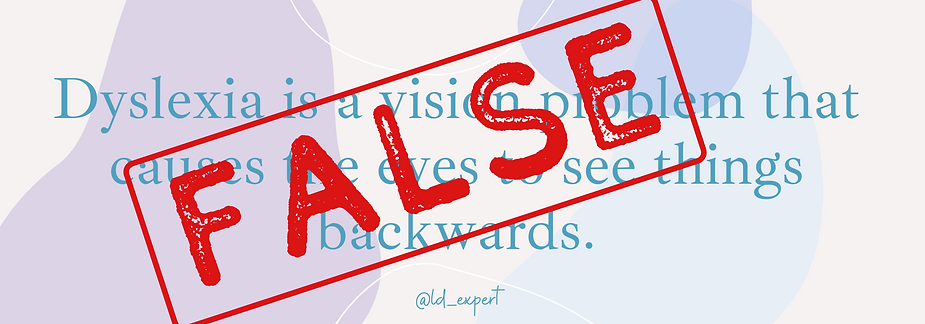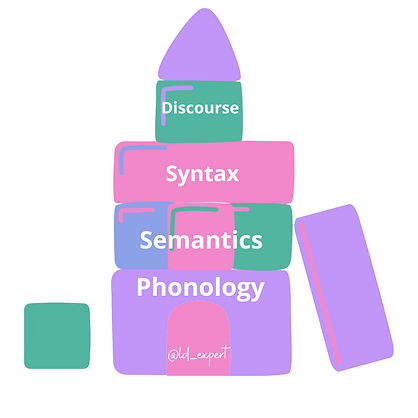Debunking Dyslexia Myths

Stephanie Tsapakis
|
Published on Jul 20, 2021 · 5 min read


Stephanie Tsapakis
|
Published on Jul 20, 2021 · 5 min read

Welcome to Part IV of our Dyslexia 101 series. Over the next few weeks, our blog series will continue to focus on expanding your understanding of dyslexia.
By the end of LD Expert's Dyslexia 101 series you will be able to:
Today we will focus on debunking some common myths that surround dyslexia. The goal of this blog is to help spread more scientifically researched data and information about this common language disorder that effects 1 in 5 children.
In Part I of this blog series, we broke down the definition of dyslexia for you. In Part II, we examined the characteristics of dyslexia by outlining common struggles and strengths. Part III focused on implications of dyslexia in the classroom and workplace.
Today is a bit more fun - we get to play Myth Busters and debunk the following misconceptions:

This is a pretty common myth surrounding dyslexia. It likely comes from the fact that many students with dyslexia reverse some letters and numbers while reading and writing. However, dyslexia is not a vision problem, it is a neurological one.
Dyslexia occurs because of a weakness in the phonological module of the brain. This little module is located within the language factory of the brain. The phonological module has two jobs:

These two skills seem small, but they are not! They are foundational, and every other way we use language is impacted by this part of the brain doing 'it's two little jobs' both rapidly and automatically. The language system used for both reading and speaking is made up of four parts that are stacked onto top of each other. Weakness in one area will result in weakness for everything above it. Think of it like a tower, with the part of the brain effected by dyslexia being at the bottom.

Unless you know what to look for, it can be difficult to spot specific learning disabilities related to language and reading in the early years (2- to 5-years-old). For tips on what types of activities younger children may struggle with, check out our post about helping your struggling reader
Additionally, people with dyslexia fall along a spectrum. This means that a student could have a very mild case, very severe, or anything in between.
Many individuals with dyslexia are extremely smart, creative, and resourceful. This means that children can be very good at compensating for reading and spelling struggles by using bypass strategies. This could "hide" their dyslexia, or make it less obvious to parents and teachers until around third grade when students are no longer learning to read, but expected to read-to-learn.
There are even many adults who recognize the struggle in their children, and begin thinking to themselves "I see a lot of the same struggles I had as a child, I wonder if I am actually dyslexic..."
Just know that dyslexia does not have ANYTHING to do with intelligence, and that it may not be extremely obvious that your child is struggling or working harder than most to read and write. This is why it is best to have a specialized and professional Speech-Language Pathologist, Educational Diagnostician, School Psychologist, or Neuropsychologist complete comprehensive diagnostic testing with your child to examine their strengths and weaknesses and make recommendations for intervention.

This is simply untrue.
According to the National Institutes of Health, dyslexia is in no way tied to IQ. These findings are scientifically supported by a study published in Psychological Science (2011) conducted by Fumiko Hoeft, M.D., Ph.D., of Stanford University and colleagues at Boston College; York University, in Toronto; and the Massachusetts Institute of Technology.
The study examined brain activity using fMRI technology, and concluded that there was not significant differences between various groups of poor readers based on their IQ scores.
Furthermore, the study indicated that all struggling readers should be eligible for reading intervention, regardless of a large or small discrepancy between IQ scores and reading ability.
(Please read that again.)

Dyslexia is a neurologically-based language disorder. This means that it is caused by differences in the way the brains works. While you can implement intervention to strengthen the connections in the brains to make reading more fluent, you cannot "cure" dyslexia.
Additionally, you cannot "grow out of" dyslexia. In fact, the longer you wait to implement explicit intervention, the larger the gap between reading ability and grade-level expectations. As a result, it becomes increasingly more difficult for children at school to keep up with both their peers and the academic demands because everything related to language requires us to have a solid phonological base.
It also worth noting that Orton-Gillingham based reading intervention programs are still the gold standard for dyslexia intervention. There are a variety of programs that promise results by strengthening parts of your brain through physical movement or sensory training. The empirical data on these programs is extremely limited. Additionally, many of these programs have been under investigation for fraud and false advertising. If you are looking for an intervention program for your child, be sure to find a certified practitioner who can implement an Orton-Gillingham program with fidelity. This means that the program will be explicit, sequential, incremental, cumulative, multisensory, and individualized.

Because there is no single one-size-fits-all standardized assessment to diagnose dyslexia, a battery of comprehensive testing, combined with an extensive case history, must be used. Within the comprehensive assessment, a specialized professional will assess all areas of language using both formal and informal measures. At the end of the comprehensive testing and score interpretation, the evaluator will be able to provide a diagnosis of dyslexia or a differential language diagnosis, as appropriate.
Many of these assessments are appropriate for use in children as young as four years of age.
If you would like to get your child evaluated through your local school district and are being told they cannot diagnose them with a Specific Learning Disability in reading until second grade, it may be time to reach out to a Special Education Advocate who can attend meeting with the school and serve as your teammate to ensure your child gets the intervention they need and are entitled to receive.
We cannot overstate how much we love Drs. Shaywitz book, Overcoming Dyslexia. It is the Gold Standard when it comes to books to help you understand and navigate life with dyslexia that is based on years of research. Here's the link again to purchase!
Looking for personalized support for your child's learning journey?
Our tutoring and dyslexia intervention services are tailored to students with learning differences. Whether it's reading, writing, or other challenges, our team offers one-on-one guidance.
Start with a consultation!Stay updated with our latest blog posts.
Cart